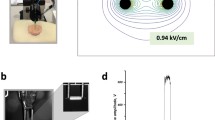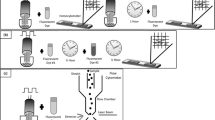Abstract
Bystander effect, a known phenomenon in radiation biology, where irradiated cells release signals which cause damage to nearby, unirradiated cells, has not been explored in electroporated cells yet. Therefore, our aim was to determine whether bystander effect is present in electroporated melanoma cells in vitro, by determining viability of non-electroporated cells exposed to medium from electroporated cells and by the release of microvesicles as potential indicators of the bystander effect. Here, we demonstrated that electroporation of cells induces bystander effect: Cells exposed to electric pulses mediated their damage to the non-electroporated cells, thus decreasing cell viability. We have shown that shedding microvesicles may be one of the ways used by the cells to mediate the death signals to the neighboring cells. The murine melanoma B16F1 cell line was found to be more electrosensitive and thus more prone to bystander effect than the canine melanoma CMeC-1 cell line. In B16F1 cell line, bystander effect was present above the level of electropermeabilization of the cells, with the threshold at 800 V/cm. Furthermore, with increasing electric field intensities and the number of pulses, the bystander effect also increased. In conclusion, electroporation can induce bystander effect which may be mediated by microvesicles, and depends on pulse amplitude, repetition frequency and cell type.







Similar content being viewed by others
References
Agarwal A, Zudans I, Weber EA, Olofsson J, Orwar O, Weber SG (2007) Effect of cell size and shape on single-cell electroporation. Anal Chem 79:3589–3596
Al-Mayah AHJ, Irons SL, Pink RC, Carter DRF, Kadhim MA (2012) Possible role of exosomes containing RNA in mediating nontargeted effect of ionizing radiation. Radiat Res 177:539–545
Azzam EI, de Toledo SM, Gooding T, Little JB (1998) Intercellular communication is involved in the bystander regulation of gene expression in human cells exposed to very low fluences of alpha particles. Radiat Res 150:497–504
Baskar R (2010) Emerging role of radiation induced bystander effects: cell communications and carcinogenesis. Genome Integr 1:13
Ben-Dov N, Rozman Grinberg I, Korenstein R (2012) Electroendocytosis is driven by the binding of electrochemically produced protons to the cell’s surface. PLoS One 7:e50299
Bobrie A, Colombo M, Raposo G, Théry C (2011) Exosome secretion: molecular mechanisms and roles in immune responses. Traffic 12:1659–1668
Bobrie A, Colombo M, Krumeich S, Raposo G, Théry C (2012) Diverse subpopulations of vesicles secreted by different intracellular mechanisms are present in exosome preparations obtained by differential ultracentrifugation. J Extracell Vesicles 1:18397
Calvet CY, Famin D, Andre FM, Mir LM (2014) Electrochemotherapy with bleomycin induces hallmarks of immunogenic cell death in murine colon cancer cells. OncoImmunology 3:e28131
Cemazar M, Jarm T, Miklavcic D, Lebar AM, Ihan A, Kopitar NA, Sersa G (1998) Effect of electric-field intensity on electropermeabilization and electrosensitivity of various tumor-cell lines in vitro. Electro Magnetobiol 17:263–272
Colombo M, Raposo G, Théry C (2014) Biogenesis, secretion, and intercellular interactions of exosomes and other extracellular vesicles. Annu Rev Cell Dev Bi 30:255–289
Davalos R, Mir LM, Rubinsky B (2005) Tissue ablation with irreversible electroporation. Ann Biomed Eng 33:223–231
Davis DM (2007) Intercellular transfer of cell-surface proteins is common and can affect many stages of an immune response. Nat Rev Immunol 7:238–243
Deng L, Liang H, Fu S, Weichselbaum RR, Fu Y (2016) From DNA damage to nucleic acid sensing: a strategy to enhance radiation therapy. Clin Cancer Res 22:20–25
Edd JF, Horowitz L, Davalos RF, Mir LM, Rubinsky B (2006) In-vivo results of a new focal tissue ablation technique: irreversible electroporation. IEEE Trans Biomed Eng 53:1409–1415
El-Andaloussi S, Mäger I, Breakefield XO, Wood MJ (2013) Extracellular vesicles: biology and emerging therapeutic opportunities. Nat Rev Drug Discov 12:347–357
Forde PF, Sadadcharam M, Hall LJ, O’Donovan TR, de Kruijf M, Byrne WL, O’Sullivan GC, Soden DM (2014) Enhancement of electroporation facilitated immunogene therapy via T-reg depletion. Cancer Gene Ther 21:349–354
Franken NAP, Rodermond HM, Stap J, Haveman J, van Bree C (2006) Clonogenic assay of cells in vitro. Nat Protoc 1:2315–2319
Gorman S, Tosetto M, Lyng F, Howe O, Sheahan K, O’Donoghue D, Hyland J, Mulcahy H, O’Sullivan J (2009) Radiation and chemotherapy bystander effects induce early genomic instability events: telomere shortening and bridge formation coupled with mitochondrial dysfunction. Mutat Res 669:131–138
Hall EJ, Giaccia AJ (2006) Radiobiology for the radiologist. Lippincott Williams & Wilkins, Philadelphia, pp 35–36
Hatzi VI, Laskaratou DA, Mavragani IV, Nikitaki Z, Mangelis A, Panayiotidis MI, Pantelias GE, Terzoudi GI, Georgakilas AG (2015) Non-targeted radiation effects in vivo: a critical glance of the future in radiobiology. Cancer Lett 356:34–42
Hei TK, Zhou H, Ivanov VN, Hong M, Lieberman HB, Brenner DJ, Amundson SA, Geard CR (2008) Mechanism of radiation-induced bystander effects: a unifying model. J Pharm Pharmacol 60:943–950
Heller R, Gilbert R, Jaroszeski MJ (1997) Electrochemotherapy: an emerging drug delivery method for the treatment of cancer. Adv Drug Deliv Rev 26:185–197
Heller L, Todorovic V, Cemazar M (2013) Electrotransfer of single-stranded or double-stranded DNA induces complete regression of palpable B16.F10 mouse melanomas. Cancer Gene Ther 20:695–700
Inoue K, Ohashi E, Kadosawa T, Hong SH, Matsunaga S, Mochizuki M, Nishimura R, Sasaki N (2004) Establishment and characterization of four canine melanoma cell lines. J Vet Med Sci 66:1437–1440
Klammer H, Mladenov E, Li F, Iliakis G (2015) Bystander effects as manifestation of intercellular communication of DNA damage and of the cellular oxidative status. Cancer Lett 356:58–71
Kos B, Voigt P, Miklavcic D, Moche M (2015) Careful treatment planning enables safe ablation of liver tumors adjacent to major blood vessels by percutaneous irreversible electroporation (IRE). Radiol Oncol 49:234–241
Kumar Jella K, Rani S, O’Driscoll L, McClean B, Byrne HJ, Lyng FM (2014) Exosomes are involved in mediating radiation induced bystander signalling in human keratinocyte cells. Radiat Res 181:138–145
Lampreht U, Kamensek U, Stimac M, Sersa G, Tozon N, Bosnjak M, Brozic A, de Sá Oliveira GG, Nakagawa T, Saeki K, Cemazar M (2015) Gene electrotransfer of canine interleukin 12 into canine melanoma cell lines. J Membr Biol 248:909–917
Marín A, Martín M, Liñán O, Alvarenga F, López M, Fernández L, Büchser D, Cerezo L (2015) Bystander effects and radiotherapy. Rep Pract Oncol Radiother 20:12–21
Miller L, Leor J, Rubinsky B (2005) Cancer cells ablation with irreversible electroporation. Technol Cancer Res Treat 4:699–706
Mir LM, Belehdradek M, Domenge C, Orlowski S, Poddevin J, Schwab G, Luboinnski B, Paoletti C (1991) Electrochemotherapy, a new antitumor treatment: first clinical trial. C R Acad Sci III Sci Vie 313:613–618
Mothersill C, Seymour C (1997) Medium from irradiated human epithelial cells but not human fibroblasts reduces the clonogenic survival of unirradiated cells. Int J Radiat Biol 71:421–427
Mothersill C, Seymour C (1998) Cell–cell contact during gamma irradiation is not required to induce a bystander effect in normal human keratinocytes: evidence for release during irradiation of a signal controlling survival into the medium. Radiat Res 149:256–262
Nagasawa H, Little JB (1992) Induction of sister chromatid exchanges by extremely low doses of α-particles. Cancer Res 52:6394–6396
Neumann E, Schaefer-Ridder M, Wang Y, Hofschneider PH (1982) Gene transfer into mouse lyoma cells by electroporation in high electrical fields. EMBO J 1:841–845
Ogorevc E, Kralj-Iglic V, Veranic P (2013) The role of extracellular vesicles in phenotypic cancer transformation. Radiol Oncol 47:197–205
Orlowski S, Behradek J Jr, Paoletti C, Mir LM (1988) Transient electropermeabilization of cells in culture. Increase in the cytotoxicity of anticancer drugs. Biochem Pharmacol 37:4724–4733
Potter H, Heller R (2003) Transfection by electroporarion. Curr Protoc Mol Biol. doi:10.1002/0471142727.mb0903s62
Rols MP (2006) Electropermeabilization, a physical method for the delivery of therapeutic molecules into cells. Biochim Biophys Acta 1758:423–428
Sersa G, Miklavcic D, Cemazar M, Belehradek J Jr, Jarm T, Mir LM (1997) Electrochemotherapy with CDDP on LPB sarcoma: comparison of the anti-tumor effectiveness in immunocompetent and immunodeficient mice. Bioelectrochem Bioenerg 43:279–283
Sersa G, Teissie J, Cemazar M, Signori E, Kamensek U, Marshall G, Miklavcic D (2015) Electrochemotherapy of tumors as in situ vaccination boosted by immunogene electrotransfer. Cancer Immunol Immunother 64:1315–1327
Skog J, Wurdinger T, van Rijn S, Meijer DH, Gainche L, Sena-Esteves M (2008) Glioblastoma microvesicles transport RNA and proteins that promote tumour growth and provide diagnostic biomarkers. Nat Cell Biol 10:1470–1476
Son RS, Smith KC, Gowrishankar TR, Vernier PT, Weaver JC (2014) Basic features of a cell electroporation model: illustrative behavior for two very different pulses. J Membr Biol 247:1209–1228
Tarek M (2005) Membrane electroporation: a molecular dynamics simulation. Biophys J 88:4045–4053
Théry C, Ostrowski M, Segura E (2009) Membrane vesicles as conveyors of immune responses. Nat Rev Immunol 9:581–593
Valadi H, Ekstrom K, Bossios A, Sjostrand M, Lee JJ, Lotvall JO (2007) Exosome-mediated transfer of mRNAs and microRNAs is a novel mechanism of genetic exchange between cells. Nat Cell Biol 9:654–659
Valerie K, Yacoub A, Hagan MP, Curiel DT, Fisher PB, Grant S, Dent P (2007) Radiation-induced cell signaling: inside-out and outside-in. Mol Cancer Ther 6:789–798
Yang H, Asaad N, Held KD (2005) Medium-mediated intercellular communication is involved in bystander responses of X-ray-irradiated normal human fibroblasts. Oncogene 24:2096–2103
Yarmush ML, Golberg A, Sersa G, Kotnik T, Miklavcic D (2014) Electroporation-based technologies for medicine: principles, applications, and challenges. Annu Rev Biomed Eng 16:295–320
Acknowledgments
This work was financially supported by the Slovenian Research Agency (Program No. P3-0003, Project Nos. J3-4211, J3-6793, J3-4259, J3-6796) and conducted within the scope of LEA EBAM (French-Slovenian European Associated Laboratory: Pulsed Electric Fields Applications in Biology and Medicine) and COST Action. We would also like to thank Mira Lavric (Institute of Oncology Ljubljana, Ljubljana, Slovenia) for her help with the cell culturing, Ilija Vojvodic and Alenka Vavtar (Institute of Oncology Ljubljana, Ljubljana, Slovenia) for their help with the irradiation of the cells and Andreja Brozic and Simon Bucek (Institute of Oncology Ljubljana, Ljubljana, Slovenia) for their help with flow cytometric measurements.
Author information
Authors and Affiliations
Corresponding author
Rights and permissions
About this article
Cite this article
Prevc, A., Bedina Zavec, A., Cemazar, M. et al. Bystander Effect Induced by Electroporation is Possibly Mediated by Microvesicles and Dependent on Pulse Amplitude, Repetition Frequency and Cell Type. J Membrane Biol 249, 703–711 (2016). https://doi.org/10.1007/s00232-016-9915-0
Received:
Accepted:
Published:
Issue Date:
DOI: https://doi.org/10.1007/s00232-016-9915-0




